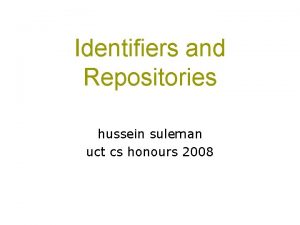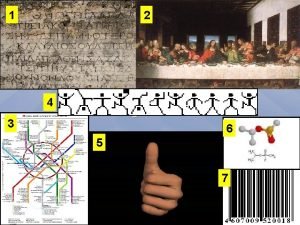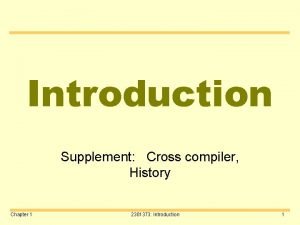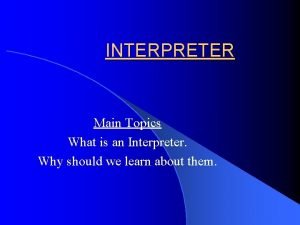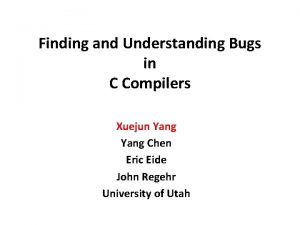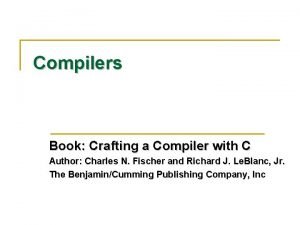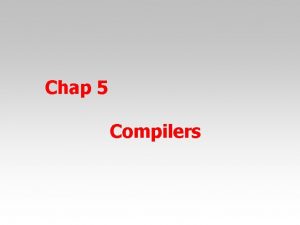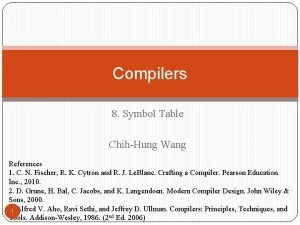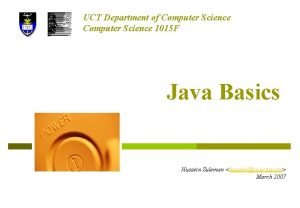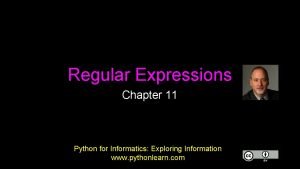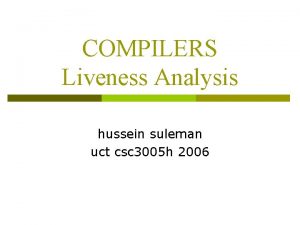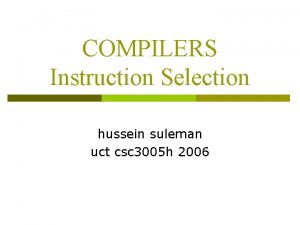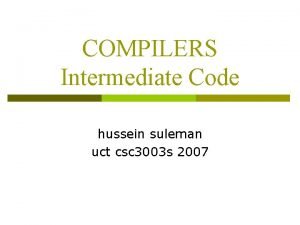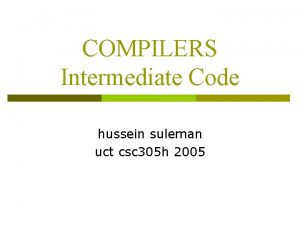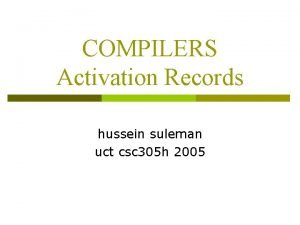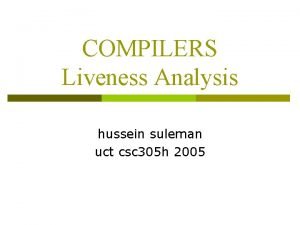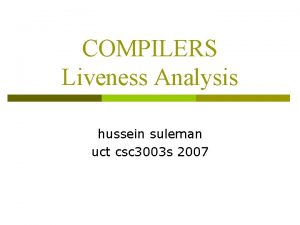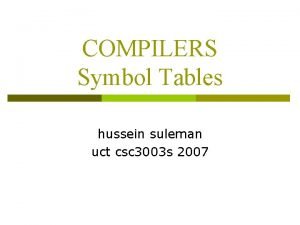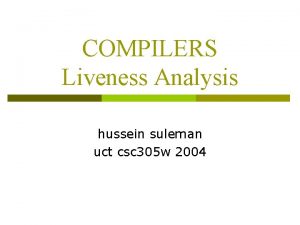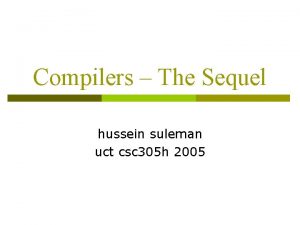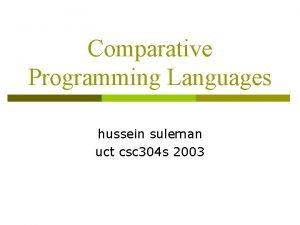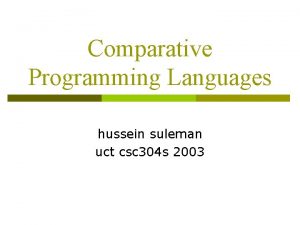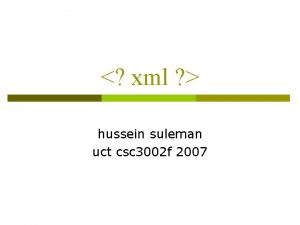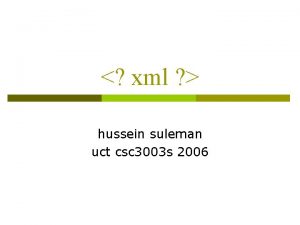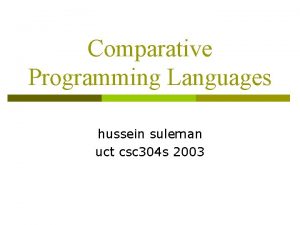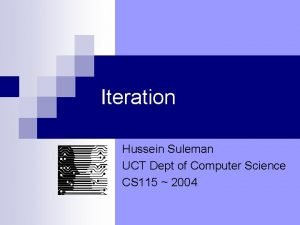COMPILERS Intermediate Code hussein suleman uct csc 3005












![Array creation p t[e 1] of e 2: n Ex(external. Call(”init. Array”, [e 1. Array creation p t[e 1] of e 2: n Ex(external. Call(”init. Array”, [e 1.](https://slidetodoc.com/presentation_image_h2/daddb6e486672e1620498e33f6a38263/image-13.jpg)
![General 1 -Dimensional Arrays p var a : ARRAY [2. . 5] of integer; General 1 -Dimensional Arrays p var a : ARRAY [2. . 5] of integer;](https://slidetodoc.com/presentation_image_h2/daddb6e486672e1620498e33f6a38263/image-14.jpg)

![Multidimensional Arrays 2/3 p array [1. . N, 1. . M] of T n Multidimensional Arrays 2/3 p array [1. . N, 1. . M] of T n](https://slidetodoc.com/presentation_image_h2/daddb6e486672e1620498e33f6a38263/image-16.jpg)





![If Expressions 1/3 [not for exams] If statements used as expressions are best considered If Expressions 1/3 [not for exams] If statements used as expressions are best considered](https://slidetodoc.com/presentation_image_h2/daddb6e486672e1620498e33f6a38263/image-22.jpg)











- Slides: 33

COMPILERS Intermediate Code hussein suleman uct csc 3005 h 2006

IR Trees An Intermediate Representation is a machine-independent representation of the instructions that must be generated. p We translate ASTs into IR trees using a set of rules for each of the nodes. p Why use IR? p n n n IR is easier to apply optimisations to. IR is simpler than real machine code. Separation of front-end and back-end.

IR Trees – Expressions 1/2 CONST i NAME n TEMP t MEM m Integer constant i Symbolic constant n Temporary t - a register Contents of a word of memory starting at m

IR Trees – Expressions 2/2 BINOP op e 1 e 2 CALL f (e 1…. en) ESEQ s e e 1 op e 2 - Binary operator Evaluate e 1, then e 2, then apply op to e 1 and e 2 Procedure call: evaluate f then the arguments in order, then call f Evaluate s for side effects then e for the result

IR Trees – Statements 1/2 MOVE TEMP e Evaluate e then move the result to temporary t t MOVE MEM e 2 e 1 EXP e Evaluate e 1 giving address a, then evaluate e 2 and move the result to address a Evaluate e then discard the result

IR Trees – Statements 2/2 JUMP e (l 1…. ln) CJUMP op ee 1 e 2 t f SEQ s 1 s 2 LABEL n Transfer control to address e; optional labels l 1. . ln are possible values for e Evaluate e 1 then e 2; compare the results using relational operator op; jump to t if true, f if false The statement S 1 followed by statement s 2 Define constant value of name n as current code address; NAME(n) can be used as target of jumps, calls, etc.

Expression Classes 1/2 Expression classes are an abstraction to support conversion of expression types (expressions, statements, etc. ) p Expressions are indicated in terms of their natural form and then “cast” to the form needed where they are used. p Expression classes are not necessary in a compiler but make expression type conversion easier when generating code. p

Expression Classes 2/2 p Ex(exp) expressions that compute a value p Nx(stm) statements that compute no value, but may have side-effects p Rel. Cx (op, l, r) conditionals that encode conditional expressions (jump to true and false destinations)

Casting Expressions p Conversion operators allow use of one form in context of another: n n n p p p un. Ex: convert to tree expression that computes value of inner tree. un. Nx: convert to tree statement that computes inner tree but returns no value. un. Cx(t, f): convert to statement that evaluates inner tree and branches to true destination if non-zero, false destination otherwise. Trivially, un. Ex (Exp (e)) = e Trivially, un. Nx (Stm (s)) = s But, un. Nx (Exp (e)) = MOVE[TEMP t, e]

Translation p Simple Variables n simple variable v in the current procedure’s stack frame MEM BINOP PLUS TEMP fp CONST k n could be abbreviated to: MEM + TEMP fp CONST k

Expression Example p Consider the statement: n p A = (B + 23) * 4; This would get translated into: n Nx ( MOVE ( MEM ( +(TEMP fp, CONST k_A) ), *( +( MEM ( +(TEMP fp, CONST k_B) ), CONST 23 ), CONST 4 ) )

Simple Array Variables p Mini. Java arrays are pointers to array base, so fetch with a MEM like any other variable: n p Thus, for e[I]: n n p Ex(MEM(+(TEMP fp, CONST k))) Ex(MEM(+(e. un. Ex, x(i. un. Ex, CONST w)))) i is index expression and w is word size – all values are word-sized (scalar) Note: must first check array index i<size(e); runtime can put size in word preceding array base
![Array creation p te 1 of e 2 n Exexternal Callinit Array e 1 Array creation p t[e 1] of e 2: n Ex(external. Call(”init. Array”, [e 1.](https://slidetodoc.com/presentation_image_h2/daddb6e486672e1620498e33f6a38263/image-13.jpg)
Array creation p t[e 1] of e 2: n Ex(external. Call(”init. Array”, [e 1. un. Ex, e 2. un. Ex]))
![General 1 Dimensional Arrays p var a ARRAY 2 5 of integer General 1 -Dimensional Arrays p var a : ARRAY [2. . 5] of integer;](https://slidetodoc.com/presentation_image_h2/daddb6e486672e1620498e33f6a38263/image-14.jpg)
General 1 -Dimensional Arrays p var a : ARRAY [2. . 5] of integer; p a[e] translates to: n MEM(+(TEMP fp, +(CONST k-2 w, x(CONST w, e. un. Ex)))) p p where k is offset of static array from fp, w is word size In Pascal, multidimensional arrays are treated as arrays of arrays, so A[i, j] is equivalent to A[i][j], so can translate as above.

Multidimensional Arrays 1/3 p Array layout: n Contiguous: p Row major § Rightmost subscript varies most quickly: § A[1, 1], A[1, 2], . . . § A[2, 1], A[2, 2], . . . § Used in PL/1, Algol, Pascal, C, Ada, Modula-3 p Column major § Leftmost subscript varies most quickly: § A[1, 1], A[2, 1], . . . § A[1, 2], A[2, 2], § Used in FORTRAN n By vectors p Contiguous vector of pointers to (non-contiguous) subarrays
![Multidimensional Arrays 23 p array 1 N 1 M of T n Multidimensional Arrays 2/3 p array [1. . N, 1. . M] of T n](https://slidetodoc.com/presentation_image_h2/daddb6e486672e1620498e33f6a38263/image-16.jpg)
Multidimensional Arrays 2/3 p array [1. . N, 1. . M] of T n Equivalent to : p p no. of elt’s in dimension j: n p array [1. . N] of array [1. . M] of T Dj = Uj - Lj + 1 Memory address of A[i 1, . . . , in]: n Memory addr. of A[L 1 , …, Ln] + sizeof(T) * [ + (in - Ln) + (in-1 - Ln-1) * Dn + (in-2 - Ln-2) * Dn-1 +… + (i 1 - L 1) * Dn-1 * … * D 2 ]

Multidimensional Arrays 3/3 p which can be rewritten as Variable part p i 1*D 2*…*Dn + i 2*D 3*…*Dn + … + in-1 * Dn + in p - (L 1 *D 2*…*Dn + L 2*D 3*…*Dn + … + Ln-1 * Dn + Ln) Constant part p address of A[i 1, …, in]: n address(A) + ((variable part - constant part) * element size)

Record Variables p Records are pointers to record base, so fetch like other variables. For e. f n Ex(MEM(+(e. un. Ex, CONST o))) p p where o is the byte offset of the field in the record Note: must check record pointer is non-nil (i. e. , non-zero)

Record Creation p t{f 1=e 1; f 2=e 2; …. ; fn=en} in the (preferably GC’d) heap, first allocate the space then initialize it: n n Ex( ESEQ(MOVE(TEMP r, external. Call(”alloc. Record”, [CONST n])), SEQ(MOVE(MEM(TEMP r), e 1. un. Ex)), SEQ(. . . , MOVE(MEM(+(TEMP r, CONST(n 1)w)), en. un. Ex))), TEMP r)) where w is the word size

String Literals p Statically allocated, so just use the string’s label n p Ex(NAME( label)) where the literal will be emitted as: n n . word 11 label: . ascii "hello world"

Comparisons p Translate a op b as: n p When used as a conditional un. Cx(t, f) yields: n n p Rel. Cx( op, a. un. Ex, b. un. Ex) CJUMP( op, a. un. Ex, b. un. Ex, t, f ) where t and f are labels. When used as a value un. Ex yields: n ESEQ(MOVE(TEMP r, CONST 1), SEQ(un. Cx(t, f), SEQ(LABEL f, SEQ(MOVE(TEMP r, CONST 0), LABEL t)))), TEMP r)
![If Expressions 13 not for exams If statements used as expressions are best considered If Expressions 1/3 [not for exams] If statements used as expressions are best considered](https://slidetodoc.com/presentation_image_h2/daddb6e486672e1620498e33f6a38263/image-22.jpg)
If Expressions 1/3 [not for exams] If statements used as expressions are best considered as a special expression class to avoid spaghetti JUMPs. p Translate if e 1 then e 2 else e 3 into: p n p If. Then. Else. Exp(e 1, e 2, e 3) When used as a value un. Ex yields: n ESEQ(SEQ(e 1. un. Cx(t, f), SEQ(LABEL t, SEQ(MOVE(TEMP r, e 2. un. Ex), JUMP join)), SEQ(LABEL f, SEQ(MOVE(TEMP r, e 3. un. Ex), JUMP join)))), LABEL join), TEMP r)

If Expressions 2/3 p As a conditional un. Cx(t, f) yields: n n n SEQ(e 1. un. Cx(tt, ff), SEQ(LABEL tt, e 2. un. Cx(t, f )), SEQ(LABEL ff, e 3. un. Cx(t, f ))))

If Expressions 3/3 p Applying un. Cx(t, f) to “if x<5 then a>b else 0”: n n n p SEQ(CJUMP(LT, x. un. Ex, CONST 5, tt, ff), SEQ(LABEL tt, CJUMP(GT, a. un. Ex, b. un. Ex, t, f )), SEQ(LABEL ff, JUMP f ))) or more optimally: n n SEQ(CJUMP(LT, x. un. Ex, CONST 5, tt, f ), SEQ(LABEL tt, CJUMP(GT, a. un. Ex, b. une. X, t, f )))

While Loops 1/2 p while c do s: n n n evaluate c if false jump to next statement after loop if true fall into loop body branch to top of loop e. g. , test: p if not(c)jump done p s p jump test p done: p

While Loops 2/2 p The tree produced is: p Nx( SEQ(SEQ(LABEL test, c. un. Cx( body, done)), SEQ(LABEL body, s. un. Nx), JUMP(NAME test))), LABEL done)) p repeat e 1 until e 2 is the same with the evaluate/compare/branch at bottom of loop

For Loops 1/2 p for i: = e 1 to e 2 do s n n n evaluate lower bound into index variable evaluate upper bound into limit variable if index > limit jump to next statement after loop fall through to loop body increment index if index < limit jump to top of loop body

For Loops 2/2 t 1 <- e 1 t 2 <- e 2 if t 1 > t 2 jump done body: s t 1 <- t 1 +1 if t 1 < t 2 jump body done:

Break Statements when translating a loop push the done label on some stack p break simply jumps to label on top of stack p when done translating loop and its body, pop the label p

Case Statement 1/3 p case E of V 1 : S 1. . . Vn: Sn end n n p evaluate the expression find value in list equal to value of expression execute statement associated with value found jump to next statement after case Key issue: finding the right case n sequence of conditional jumps (small case set) p n binary search of an ordered jump table (sparse case set) p n O(|cases|) O(log 2 |cases| ) hash table (dense case set) p O(1)

Case Statement 2/3 case E of V 1 : S 1. . . Vn: Sn end p One translation approach: p t : =expr jump test L 1 : code for S 1; jump next L 2 : code for S 2; jump next. . . Ln: code for Sn jump next test: if t = V 1 jump L 1 if t = V 2 jump L 2. . . if t = Vn jump Ln code to raise run-time exception next:

Case Statement 3/3 p Another translation approach: t : =expr check t in bounds of 0…n-1 if not code to raise runtime exception jump jtable + t L 1 : code for S 1; jump next L 2 : code for S 2; jump next. . . Ln: code for Sn jump next Jtable: jump L 1 jump L 2. . . jump Ln next:

Function Calls p f(e 1; …. . ; en): n p where sl is the static link for the callee f n p Ex(CALL(NAME label f , [sl, e 1 , . . . en])) Non-local references can be found by following m static links from the caller, m being the difference between the levels of the caller and the callee. In OO languages, you can also explicitly pass “this”.
 Hussein suleman
Hussein suleman Hussein suleman
Hussein suleman Hussein suleman
Hussein suleman Hussein suleman
Hussein suleman Hussein suleman
Hussein suleman 0101 0010 0000 0110 1000
0101 0010 0000 0110 1000 Suleman ahmer
Suleman ahmer Cs 421 programming languages and compilers
Cs 421 programming languages and compilers C++ binarymove
C++ binarymove Cross compilers
Cross compilers What is an interpreter
What is an interpreter Finding and understanding bugs in c compilers
Finding and understanding bugs in c compilers Compilers book
Compilers book Function of compiler
Function of compiler Back end compiler
Back end compiler Lex leblanc
Lex leblanc Interpreter in compiler construction
Interpreter in compiler construction Cs 421 programming languages and compilers
Cs 421 programming languages and compilers Busceral
Busceral University of chemistry and technology prague tuition fee
University of chemistry and technology prague tuition fee Uct air force
Uct air force Uct summer school
Uct summer school Nadia chalkley uct
Nadia chalkley uct Uct software engineering
Uct software engineering From [email protected] sat jan 5 09:14:16 2008
From [email protected] sat jan 5 09:14:16 2008 Hrec uct
Hrec uct Redcap uct
Redcap uct Uct
Uct Fbml
Fbml Uct access control
Uct access control Uct algorithm
Uct algorithm Uct information management
Uct information management Hpc virtualization
Hpc virtualization Uct information management
Uct information management



